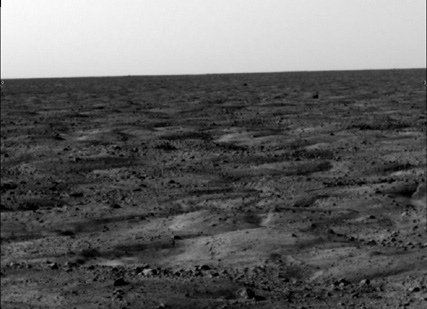Phoenix Lander Safely on Mars

Phoenix Lander First Picture of the Martian Surface
Hurray. The Phoenix Lander has survived Entry, Descent, and Landing (EDL) to arrive safely on the surface of Mars. The radio signal indicating its success was received at NASA JPL at 4:53:44 p.m. Pacific Time. The signal was relayed from Phoenix to Earth via Mars Odyssey, now in orbit around Mars.
As I write this Phoenix has been on the surface of Mars for almost three and a half hours. Phoenix was launched August 4, 2007 and followed a Type II trajectory to Mars. It has landed in an arctic lowland plain in a vast region known as Vastitas Borealis. The longitude of the Phoenix landing site is 233 degrees East longitude. This lies to the east of the line of longitude on which the volcano Arsia Mons sits. Phoenix's latitude is 68 degrees North. On Earth this would be in northern Greenland and very close to the Artic Circle.
Phoenix's prime mission is to last 90 days. Believe it when you are told that this won't be like the MER missions which have outlived their 90 day mission by years. Right now summer is just starting in the northern hemisphere of Mars and the Sun will be above the horizon all day. But as winter approaches, less and less sunlight will reach the solar arrays and the nights will get colder and colder. And there will come a day when the Sun doesn't rise and before the winter is over Phoenix could well be buried under a foot or more of dry ice – the Martian version of snow. So this mission will effectively end sometime this November when Mars passes behind the Sun from our perspective and all communications with the red planet are cut off.
So Phoenix will have a short life, but let's hope that it is a very productive one.
Ad Astra, Jim
P.S. My interview with WBBM radio (780 AM) about the Phoenix mission is to air sometime tomorrow (Monday). Sometime after airing, the full 30 minute interview will be posted to their web site.
| Return to the Blog Index | This entry was posted on Sunday, May 25th, 2008 at 9:34 pm and is filed under Mars.